Related Research Articles

Bristol Parkway, on the South Wales Main Line, is in the Stoke Gifford area in the northern suburbs of the Bristol conurbation. It is 112 miles (180 km) from London Paddington. The station was opened in 1972 by British Rail, and was the first in a new generation of park and ride/parkway stations. It is the third-most heavily used station in the West of England local authority area, after Bristol Temple Meads and Bath Spa. There are four platforms, and a well-equipped waiting area. The station is managed by Great Western Railway, who provide most of the trains at the station, with CrossCountry providing the rest.

Network Rail Limited is the owner and infrastructure manager of most of the railway network in Great Britain. Network Rail is an "arm's length" public body of the Department for Transport with no shareholders, which reinvests its income in the railways.

NI Railways, also known as Northern Ireland Railways (NIR) ; and for a brief period Ulster Transport Railways (UTR), is the railway operator in Northern Ireland. NIR is a subsidiary of Translink, whose parent company is the Northern Ireland Transport Holding Company (NITHCo), and is one of seven publicly owned train operators in the United Kingdom, the others being Direct Rail Services, Northern Trains, Transport for Wales Rail, Southeastern, LNER, and ScotRail. It has a common Board of Management with the other two companies in the group, Ulsterbus and Metro.
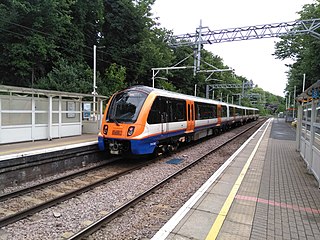
The Gospel Oak to Barking line is a railway line in London. It is 13 miles 58 chains (22.1 km) in length and carries both through goods trains and London Overground passenger trains, connecting Gospel Oak in north London and Barking Riverside in east London. The line is part of Network Rail Strategic Route 6, and is classified as a London and South East Commuter line.
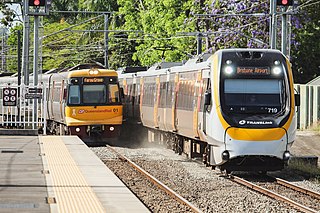
Queensland Rail (QR) is a railway operator in Queensland, Australia. Owned by the Queensland Government, it operates local and long-distance passenger services, as well as owning and maintaining approximately 6,600 kilometres of track and related infrastructure.
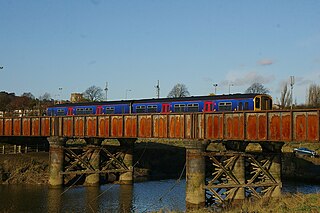
The Severn Beach line is a local railway line in Bristol and South Gloucestershire, England. It runs from Bristol Temple Meads to Severn Beach, and used to extend to Pilning. The first sections of the line were opened in 1863 as part of the Bristol Port Railway and Pier, the section through Bristol was opened in 1875 as the Clifton Extension Railway. The line has faced several threats of closure over the years, and has been reduced to single track in many places. In recent years however it has experienced a surge in passenger numbers, with a 90% increase in the years 2007–11. All services along the line are operated by Great Western Railway, generally two trains per hour in each direction between Temple Meads and Avonmouth, calling at all stations, with one train per hour extended to Severn Beach. The line carries little freight traffic, with most of the heavy freight traffic to Avonmouth Docks being routed via the Henbury Loop Line through Filton. The line has been highlighted by Thomas Cook as one of the scenic lines of Europe.
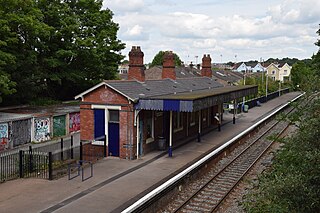
Redland railway station is on the Severn Beach Line and serves the districts of Cotham and Redland in Bristol, England. It is 3.3 miles (5.3 km) from Bristol Temple Meads. Its three letter station code is RDA. As of 2015 it is managed by Great Western Railway, which is the third franchise to be responsible for the station since privatisation in 1997. They provide all train services at the station, mainly a train every 30 minutes in each direction.
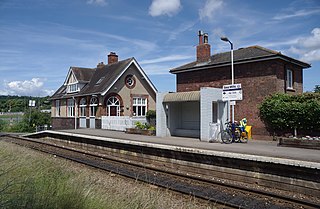
Sea Mills railway station is on the Severn Beach Line and serves the district of Sea Mills and nearby Westbury on Trym in Bristol, England. It is 6 miles (9.7 km) from Bristol Temple Meads, situated at the confluence of the River Avon and River Trym and near the A4 Bristol Portway. Its three letter station code is SML. The station has a single platform which serves trains in both directions. As of 2015 it is managed by Great Western Railway, which is the third franchise to be responsible for the station since privatisation in 1997. They provide all train services at the station, mainly a train every 30 minutes in each direction.
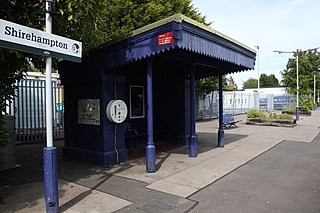
Shirehampton railway station is on the Severn Beach Line and serves the district of Shirehampton in Bristol, England. It is 7.6 miles (12.2 km) from Bristol Temple Meads. Its three letter station code is SHH. The station has a single platform which serves trains in both directions. As of 2015 it is managed by Great Western Railway, which is the third franchise to be responsible for the station since privatisation in 1997. They provide all train services at the station, mainly a train every 30 minutes in each direction.

Avonmouth railway station is located on the Severn Beach Line and serves the district of Avonmouth in Bristol, England. It is 9.0 miles (14.5 km) from Bristol Temple Meads. Its three letter station code is AVN. The station has two platforms, on either side of two running lines. As of 2015 it is managed by Great Western Railway, which is the third franchise to be responsible for the station since privatisation in 1997. They provide all train services at the station, mainly a train every 30 minutes to Bristol Temple Meads and one every hour to Severn Beach.

The period from 1995 covers the history of rail transport in Great Britain following the privatisation of British Rail. During this period, passenger volumes have grown rapidly, safety has improved, and subsidies per journey have fallen. However, there is debate as to whether this is due to privatisation or to better government regulation. During this period, High Speed 1 and the West Coast Main Line upgrade were completed and more construction projects are currently under way. In this period the Coronavirus disease 2019 (COVID-19) pandemic occurred which caused a precipitous fall off in rail travel demand.

Although Finland has no dedicated high-speed rail lines, sections of its rail network are capable of running speeds of 200 km/h (120 mph). The Finnish national railway company VR operates tilting Alstom Pendolino trains. The trains reach their maximum speed of 220 km/h in regular operation on a 75.7 km (47.0 mi) route between Kerava and Lahti. This portion of track was opened in 2006. The trains can run at 200 km/h (120 mph) on a longer route between Helsinki and Seinäjoki and peak at that speed between Helsinki and Turku. The main railway line between Helsinki and Oulu has been upgraded between Seinäjoki and Oulu to allow for trains to run at speeds between 160 km/h (99 mph) and 200 km/h (120 mph). Other parts of the Finnish railway network are limited to lower speed.

Sir David Hartmann Higgins is an Australian-British businessman, the Chairman of United Utilities Group, Chairman of Gatwick Airport, and the former Non-Executive Chairman of High Speed Two (HS2). He was Chief Executive of the London 2012 Summer Olympics Delivery Authority and Network Rail.

Pill railway station was a railway station on the Portishead Branch Line, 7.8 miles (12.6 km) west of Bristol Temple Meads, serving the village of Pill in North Somerset, England. The station was opened by the Bristol and Portishead Pier and Railway Company on 18 April 1867. It had two platforms, on either side of a passing loop, with a goods yard and signal box later additions. Services increased until the 1930s, at which point a half-hourly service operated. However the Portishead Branch was recommended for closure by the Beeching report, and the station was closed on 7 September 1964, although the line saw freight traffic until 1981. Regular freight trains through the station began to run again in 2002 when Royal Portbury Dock was connected to the rail network.

MetroWest, formerly known as the Greater Bristol Metro, is a project to improve the rail services in Bristol, England, and the surrounding region. It was first proposed at First Great Western's Stakeholder Event in March 2008. The aim of the project is to develop half-hourly services through central Bristol which will also serve the surrounding West of England region. Transport campaigning groups Friends of Suburban Bristol Railways (FoSBR) and Transport for Greater Bristol are actively supporting the proposal, as are the three unitary authorities under the West of England Combined Authority and North Somerset Council.
The Windsor Link Railway was a proposed new railway in Windsor, Berkshire, connecting the Great Western and South Western franchise areas and potentially linking both to London Heathrow Airport.

Ordsall Chord, also known as the Castlefield Curve, is a short railway line in Ordsall, Salford, England, which links Manchester Piccadilly and Manchester Oxford Road to Manchester Victoria, designed to increase capacity and reduce journey times into and through Manchester. It allows trains to run from Leeds, Newcastle and Redcar Central direct to Manchester Airport.

The South Wales Metro is an integrated heavy rail, light rail and bus-based public transport services and systems network in South East Wales around the hub of Cardiff Central. The first phase was approved for development in October 2013. Works are currently underway with a brand new depot under construction at Taff's Well and new trains being constructed at the Construcciones y Auxiliar de Ferrocarriles (CAF) 15,000 m2 factory in Newport. This will also include the electrification of the core Valley Lines and new stations. This will be the biggest overhaul to the railways of South Wales since their construction 170 years ago.

Northern Powerhouse Rail (NPR), sometimes referred to unofficially as High Speed 3, is a proposed major rail programme designed to substantially enhance the economic potential of the North of England. The phrase was adopted in 2014 for a project featuring new and significantly upgraded railway lines in the region. The aim is to transform rail services between the major towns and cities, requiring the region's single biggest transport investment since the Industrial Revolution. The original scheme would have seen a new high-speed rail line from Liverpool to Warrington continuing to join the HS2 tunnel which it would share into Manchester Piccadilly station. From there, the line would have continued to Leeds with a stop at Bradford. The line was intended to improve journey times and frequency between major Northern cities as well as creating more capacity for local service on lines that express services would have been moved out from.

East West Rail is a major project to establish a strategic railway connecting East Anglia with Central, Southern and Western England. In particular, it plans to build a line linking Oxford and Cambridge via Bicester, Milton Keynes and Bedford, largely using the trackbed of the former Varsity Line. Thus it provides a route between any or all of the Great Western, Chiltern, West Coast, Midland, East Coast, West Anglia, Great Eastern and the Cotswold main lines, avoiding London. The new line will provide a route for potential new services between Southampton Central and Ipswich or Norwich via Reading, Didcot and Ely, using existing onward lines. The government approved the western section in November 2011, with completion of this section expected by 2025. As of January 2019, the company aims to complete the Central section by "the mid 2020s". As of March 2020, electrification of the line is not planned, but the 2019 decision is under review. The plan is divided into three sections:
References
- 1 2 3 4 Odell, Mark (5 September 2013). "Former Shell executive named as Network Rail chief". Financial Times . Retrieved 25 August 2014.
- ↑ "Mark Carne". Bloomberg Businessweek . Retrieved 24 August 2014.
- 1 2 "Our board". Network Rail. Archived from the original on 29 November 2016. Retrieved 24 August 2014.
- 1 2 "Network Rail appoints new boss Mark Carne". BBC News . 5 September 2013. Retrieved 24 August 2014.
- 1 2 "Network Rail announces new chief executive". Network Rail. 5 September 2013. Archived from the original on 26 August 2014. Retrieved 25 August 2014.
- ↑ "New Network Rail boss Mark Carne to make £675,000 per year". Metro . 5 September 2013. Retrieved 25 August 2014.
- ↑ "New Network Rail chief to earn £80,000 more than predecessor". The Guardian . 5 September 2013. Retrieved 25 August 2014.
- ↑ Rail issue 746 16 April 2014 page 10
- ↑ "What reclassification means for investors". Network Rail. Retrieved 12 July 2019.
- ↑ Hendy, Peter. "George Bradshaw Address 2018" (PDF).
- ↑ "Network Rail's performance". Gov.uk . Retrieved 12 July 2019.
- ↑ "House of Commons - Network Rail's 2014-2019 investment programme - Committee of Public Accounts". publications.parliament.uk. Retrieved 12 July 2019.
- ↑ "Sir Peter Hendy report: re-planning of Network Rail's investment programme". Gov.uk. Retrieved 12 July 2019.
- ↑ "Network Rail sells railway arches for £1.5bn". 10 September 2018. Retrieved 12 July 2019.
- 1 2 Wordsworth, Nigel. "Mark Carne looks back on his time at Network Rail" . Retrieved 12 July 2019.
- ↑ McLoughlin, Patrick (30 April 2019). "The Williams Review must establish a new vision for our railway". The Daily Telegraph . ISSN 0307-1235 . Retrieved 12 July 2019.
- ↑ "Her Majesty The Queen opens redeveloped Reading station". Network Rail. Retrieved 12 July 2019.
- ↑ "Queen & Prince Philip officially open Birmingham New Street Station". ITV News . Retrieved 12 July 2019.
- ↑ "Royal Opening for London Bridge Station which offers a 'Transformation in Passenger Experience'". Network Rail. Retrieved 12 July 2019.
- ↑ "Digital rail revolution will reduce overcrowding and cut delays". Gov.uk. Retrieved 12 July 2019.
- ↑ Wordsworth, Nigel. "Understanding the commitment to the Digital Railway" . Retrieved 12 July 2019.
- ↑ "2018 Awards". Women in Rail. Retrieved 12 July 2019.
- ↑ "'Getting more women into the railway is key to better performance' says Network Rail". Network Rail. Retrieved 12 July 2019.
- ↑ "Rail infrastructure funding: statement of funds available 2019 to 2024". Gov.uk. Retrieved 12 July 2019.
- ↑ "Railnews - Speculation grows about Network Rail funding". Railnews . Retrieved 12 July 2019.
- ↑ Williams, Christopher (7 February 2018). "End of the line for rail chief just weeks after show of support". The Daily Telegraph. No. 50, 613. p. 3. ISSN 0307-1235.
- ↑ Network Rail boss will not get bonus Retrieved 3/5/21.
- ↑ "50 engineering leaders become Fellows of the Royal Academy of Engineering - Royal Academy of Engineering".